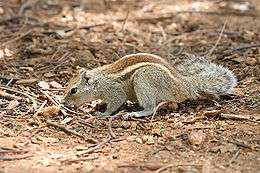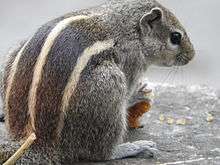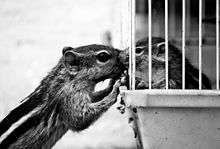Indian palm squirrel
| Indian palm squirrel | |
|---|---|
 | |
| An Indian palm squirrel | |
| Scientific classification | |
| Kingdom: | Animalia |
| Phylum: | Chordata |
| Class: | Mammalia |
| Order: | Rodentia |
| Family: | Sciuridae |
| Genus: | Funambulus |
| Subgenus: | Funambulus |
| Species: | F. palmarum |
| Binomial name | |
| Funambulus palmarum (Linnaeus, 1766) | |
| Subspecies[2] | |
| |
| Synonyms | |
|
Sciurus brodei Blyth, 1849 | |

The Indian palm squirrel or three-striped palm squirrel (Funambulus palmarum) is a species of rodent in the family Sciuridae found naturally in India (south of the Vindhyas) and Sri Lanka. In the late 19th century, the palm squirrel was introduced to Madagascar, Réunion, Mayotte, Comoro Islands, Mauritius, Seychelles and Australia, where it has since become a minor pest.[3][4] The closely related five-striped palm squirrel, F. pennantii, is found in northern India, and its range partly overlaps with this species.
Description
.jpg)


The palm squirrel is about the size of a large chipmunk, with a bushy tail slightly shorter than its body. The back is a grizzled, grey-brown colour with three conspicuous white stripes which run from head to tail. The two outer stripes run from the forelegs to the hind legs only. It has a creamy-white belly and a tail covered with interspersed, long, black and white hair. The ears are small and triangular. Juvenile squirrels have significantly lighter coloration, which gets progressively darker as they age. Albinism is rare, but exists in this species.
Life cycle
_nest_in_Hyderabad_W_IMG_4466.jpg)
The gestation period is 34 days; breeding takes place in grass nests during the autumn. Litters of two or three are common, and average 2.75. The young are weaned after about 10 weeks and are sexually mature at 9 months. Adult weight is 100 g. Little is known about their longevity, but one specimen lived 5.5 years in captivity.[5]

Diet and behaviour
These squirrels eat mainly nuts and fruits. They are fairly vocal, with a cry that sounds like "chip chip chip" when danger is present. They are opportunists in urban areas, and can be easily domesticated and trained to accept food from humans. Naturally active, their activity reaches levels of frenzy during the mating season. They tend to be very protective of their food sources, often guarding and defending them from birds and other squirrels.
Unlike some other species of squirrel, the Indian palm squirrel does not hibernate.
Importance in Hinduism
Squirrels are considered sacred in India and are not to be harmed. They are even fed by many Hindu families, mainly because of their association with Lord Rama.
A legend explains the stripes on the back of most of the squirrels. During the construction of the Rama Setu (bridge) at Rameswaram by Lord Rama and the Vanara Sena, a little squirrel also contributed in its own little way. It rolled in the beach sand and then ran to the end of the bridge to shake off the sand from its back (chanting Lord Rama's name all along).
Lord Rama, pleased by the creature's dedication, caressed the squirrel's back and ever since, the Indian squirrel carried white stripes on its back, which are believed to be the mark of Lord Rama's fingers.[6] Lord Rama and the squirrel are mentioned in one of the hymns of the Alvars.
Subspecies
Generally four valid subspecies are described according to the geographic distribution. But many more subspecies are also described, but not given validity.[7]
- Valid subspecies
- Funambulus palmarum bellaricus Wroughton, 1916
- Funambulus palmarum palmarum (Linnaeus, 1766)
- Funambulus palmarum brodiei (Blyth, 1849)
- Funambulus palmarum robertsoni Wroughton, 1916
- Invalid subspecies
- ? Funambulus palmarum bengalensis Wroughton, 1916
- ? Funambulus palmarum comorinus Wroughton, 1905
- ? Funambulus palmarum gossei Wroughton and Davidson, 1919
- ? Funambulus palmarum kelaarti (Layard, 1851)
- ? Funambulus palmarum matugamensis Lindsay, 1926
- ? Funambulus palmarum olympius Thomas and Wroughton, 1915
- ? Funambulus palmarum penicillatus (Leach, 1814)
- ? Funambulus palmarum favonicus Thomas and Wroughton, 1915
References
- ↑ Nameer, P. O. & Molur, S. (2008). "Funambulus palmarum". IUCN Red List of Threatened Species. Version 2008. International Union for Conservation of Nature. Retrieved 6 January 2009.
- ↑ Thorington, R.W., Jr.; Hoffmann, R.S. (2005). "Family Sciuridae". In Wilson, D.E.; Reeder, D.M. Mammal Species of the World: a taxonomic and geographic reference (3rd ed.). The Johns Hopkins University Press. pp. 754–818. ISBN 0-8018-8221-4. OCLC 26158608.
- ↑ Long, J. L. (2003). Introduced Mammals of the World: Their History, Distribution and Influence. Csiro Publishing, Collingwood, Australia. ISBN 9780643099166
- ↑ Farmnote 113/2000, Government of Western Australia Department and Agriculture and Food, retrieved 8/14/2008
- ↑ Human Ageing Genomic Resources, AnAge database, retrieved 7/30/2007 AnAge entry for Funambulus palmarum
- ↑ http://www.ecoheritage.cpreec.org/Viewcontall.php?$mFJyBfK$MkoNJ@juGn2
- ↑ http://www.planet-mammiferes.org/drupal/en/node/35?class=&where_classif=10&1_=1&2_=2&3_=4&4_=21&5_=30&6_=125&7_=225&8_=1003&9_=&10_=&11_=&go=&
External links
| Wikimedia Commons has media related to Funambulus palmarum. |
| Wikispecies has information related to: Funambulus palmarum |
